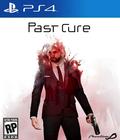Psychological horror is not easy in the realm of video games. Instead of relying on the tried-and-true jump scare, the game needs to make the player feel uneasy despite the prevailing thought that most games provide the player with a power fantasy in almost every setting. It's even harder to do if you're a small team with resources that are stretched thin. At first, Past Cure makes a solid attempt to do psychological horror right. By the end, however, it does many different things, and none of them are done particularly well.
The story is promising. You play the role of Ian, a soldier who suffers from nightmares that stem from the fact that he's been experimented on and three years of his life have been wiped from his memory. He has gained a few powers as a result, but he mostly wants revenge against the people who have done this to him. While the start is good because of the constant trips into Ian's psyche, the tale becomes less interesting as it goes on due to a myriad of story threads that pop up without any resolution.
Past Cure starts off in Ian's nightmare world, where you run around in circles and shoot at porcelain men. As an introduction, it acts as a frustrating shooting gallery. The controls for gunplay are rather loose, and one hit from these porcelain men instantly renders you dead. It adheres to the survival-horror mantra of always leaving the player with little ammo so they can't approach the situation with guns blazing.
The game takes a while for the tutorials to wrap up, as all of the mechanics are doled out in a very slow fashion. After watching countless cut scenes and roaming around the house doing menial tasks, you'll learn about your ability to use standard punches, melee attacks, counterpunches, and finishing blows. In the nightmare world, you'll learn about using stealth while also coming to grips with your newfound mental abilities. Slowing down time is self-explanatory, while astral projection lets your spirit leave your body so you can activate switches remotely. It doesn't take long to see that astral projection is woefully underutilized. Throughout the game, all you'll be doing with it is activating switches from afar. Save for two instances, you can't use it to mess with people, and although there are a few switches that require more than a key press, the act itself is mundane and wastes the potential of the power.
Both astral projection and the slowing of time utilize your sanity. It makes sense thematically, but much like projection, it feels undercooked. Sapping away all of your sanity makes the world wobbly for a second. You can use a blue pill to regain your sanity, or you can wait for it to recharge to one-third of the meter. Based on its name, you get the sense that your nightmares would carry over into the real world once sanity is depleted, but there aren't any actual consequences, so it simply acts as an artificial limit for your powers.
Outside of the nightmare world, the game transforms into a stealth-action game. Beyond solving a few switch puzzles, most of your time is e spent disabling cameras from afar and trying to take down enemies silently along their predetermined paths. Should you mess up or decide to eschew stealth, you can go in shooting and brawling with anyone you meet.
It's here that the game goes from having underutilized mechanics to just being broken. Attacking while in stealth is dodgy, since you have no control over which attack you'll implement. Simple knife slashes are preferable, but sometimes, you'll unleash a choking maneuver that takes so long you'll be seen by others. Trying to hide from others is a hit-and-miss affair, since enemies can vary wildly on their levels of perception. Sometimes, you can sneak up to a foe just fine. Other times, they'll either see through walls and spot you or somehow see you from the back of their heads when you're crouch-walking toward them. These faults are bad throughout most of the game but become infuriating during the hotel stage, where getting spotted means instant death.
Shooting is further degraded once you're out of the nightmare world. Despite the constant presence of walls and waist-high cover, the game employs no cover mechanics, so you're forced to crouch at all times to get some protection. Taking aim means that your shots are woefully inaccurate, as you'll have to wait for a second reticle to line up with your primary one in order to hit anything. Even then, headshots aren't a guaranteed hit, as the telltale sign of a fatal blow can be misleading, often taking two appearances of blood spray to confirm a kill.
The story itself is short, but the experience feels much longer due to the erratic enemy AI and poor game mechanics. If you're a Trophy hunter, the game is rather anemic in this department, since there's no Platinum at hand. There's no difficulty-related Trophy, so replaying the game on a higher difficulty isn't going to matter. Even though price should rarely matter in a review, the $30 price tag stings when you see what's offered.
The graphics follow the trajectory of the gameplay. The characters look decent until you get to their facial hair, which looks patched on and unnatural. Animations are sometimes laughable. Moving while crouching looks awkward, and mouths barely move when people speak. Interacting with anything is equally bad, since you can be far away from something and still see it react accordingly. The environments may have lots of particles, but they all look bland – with the exception of the cube dream world that you encounter early in the game. It also doesn't help that the camera tends to go wild when you're near an object, so fights and basic navigation become a chore.
As for the audio, that's also all over the place. The music, while sparse, fits thematically but is otherwise uninspiring. The sound effects feel hollow, so things like bullet impacts and malfunctioning cameras come across as weak. The voice acting, however, has plenty of issues, and this is where the sound falls apart. At times, the volume fluctuates so much that one line can be quiet while the next one is at the right volume. It doesn't help that the tone from every character is flat, so every scene that is supposed to evoke any kind of emotion feels flat instead. Hearing someone seem so unconcerned about choking or someone asking others to check out an area while sounding bored doesn't exactly make the game endearing to potential players.
Past Cure is many things: technically infuriating, a slog, and thematically inconsistent. While one can appreciate the effort of a small team trying to craft a game that does many things, it can't seem to do any of them well enough to warrant any attention. With a glut of better games that tackle similar elements on the platform, it's very difficult to recommend Past Cure to people, even as a quick diversion.
Score: 3.5/10
More articles about Past Cure










 Past Cure is a single-player, third-person shooter that neatly combines stealth elements with dynamic action sequences and stunning graphics.
Past Cure is a single-player, third-person shooter that neatly combines stealth elements with dynamic action sequences and stunning graphics.






































